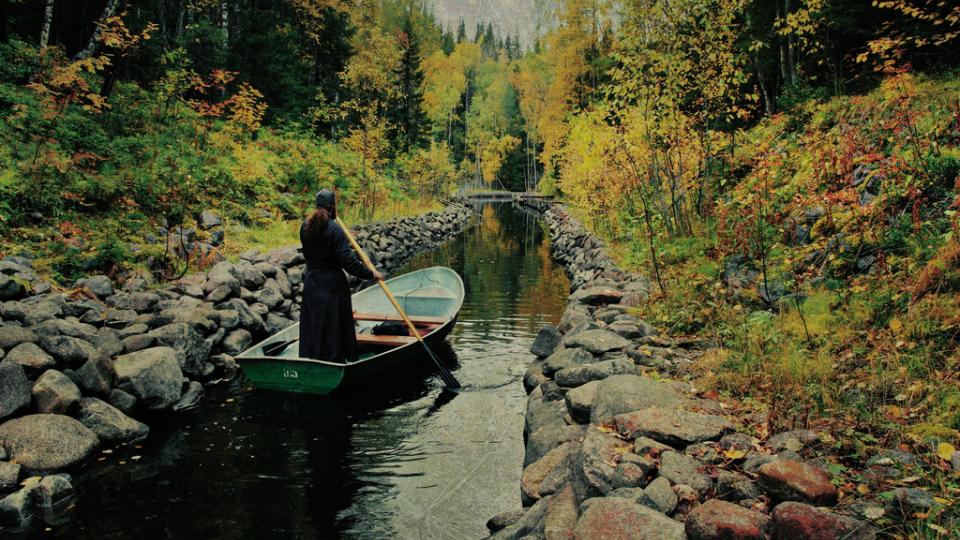The Solovetsky archipelago is located in the middle of the White Sea, 164 kilometers south of the Arctic Circle. In 1436, one of the most northerly Orthodox monasteries was founded here, situated between Svyatoe Lake and the bay.

View of Solovetsky Monastery (1780)
View of Solovetsky Monastery (1780)
Painting by Jean-Balthasar de la Traverse (1780)
Click here to view Wikimedia source.
 This work is licensed under a Creative Commons Public Domain Mark 1.0 License.
This work is licensed under a Creative Commons Public Domain Mark 1.0 License.
From that moment, the process began of adapting the northern environment to accommodate the needs of the new settlers. The most significant development was the creation of canal systems on Solovetsky island. There are no rivers on the island, but there are more than five hundred lakes. The first human-made canals were built in the fifteenth century, in order to ensure an adequate supply of fresh water. The canals, running between the lakes, served to transport drinking water to the monastery and other installations, and supplemented the lakes’ water resources. The canal system around Svyatoe Lake emerged as one of the most important, created in the mid-sixteenth century in direct proximity to the monastery. The constant flow of water into Svyatoe Lake via the supplementary canal, and from the lake to the sea, allowed for the construction of a water mill; the mechanism was propelled by water pressure from the canal.

An orthodox monk on one of the Solovetsky canals
An orthodox monk on one of the Solovetsky canals
2012 Dmitry Porechnyy
Click here to view Flickr source.
 This work is licensed under a Creative Commons Attribution-NonCommercial-ShareAlike 3.0 Unported License.
This work is licensed under a Creative Commons Attribution-NonCommercial-ShareAlike 3.0 Unported License.
In order to facilitate the drainage of water into Svyatoe, differences in elevation were taken into account in the choice of lakes. Fifty-two lakes in all were connected by canals to make a single system, so that the water ran into Svyatoe Lake and from there through underground canals to the water mill. Having done its work for the monastery, the water then flowed further along the canals and into the sea.
Moreover, the canals had a positive effect on the landscape of the archipelago. The increased flow of water to the lakes made them less marshy and improved their water cycle. Aquatic plant life became richer, the forage reserve for fish improved, and new types of fish appeared and multiplied. On the banks of the lakes, the bird population grew more numerous and diverse.
In the early twentieth century, a new canal system was built for navigation (1907–1918). The shipping canals, with their walls reinforced with boulders, connected 10 lakes in all.
How to cite
Kalemeneva, Ekaterina. “The Canal System of Bolshoy Solovetsky Island.” Environment & Society Portal, Arcadia (2014), no. 11. Rachel Carson Center for Environment and Society. https://doi.org/10.5282/rcc/5313.
ISSN 2199-3408
Environment & Society Portal, Arcadia
 This work is licensed under a Creative Commons Attribution-NonCommercial-ShareAlike 3.0 Unported License.
This work is licensed under a Creative Commons Attribution-NonCommercial-ShareAlike 3.0 Unported License.
2014 Ekaterina Kalemeneva
This refers only to the text and does not include any image rights.
Please click on the images to view their individual rights status.
- "Istoriia Pervoklassnogo Stavropigial'nogo Solovetskogo Monastyria." [The History of the Holy Transfiguration Solovki Men's Monastery]. Moscow, 2001.
- Boguslavskii, Gustav. Ostrova Solovetskie. Arkhangel'sk: Severo-zapadnoe knizhnoe izd-vo, 1978.
- Skopin, Vladimir. Na Solovetskikh ostrovakh. Moscow: Izd. Iskusstvo, 1990.








